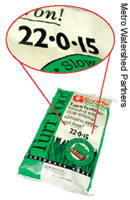“P” Stands for phosphorus
Phosphorus (P) is a nutrient found naturally in the environment and is necessary for life. But too much of it in our lakes can feed unsightly, smelly and potentially toxic cyanobacteria (also known as blue-green algae) blooms.
 WHAT’S THE FUSS ABOUT PHOSPHORUS?
WHAT’S THE FUSS ABOUT PHOSPHORUS?
Phosphorus is the most problematic pollutant in Lake Champlain and in many other lakes in Vermont and northern New York. Phosphorus is washed off the landscape and into waterways when it rains.
In cities and suburbs, fertilizers—whether organic or conventional—from lawns and gardens are a major source of phosphorus. About one-sixth of Lake Champlain’s phosphorus problem is from developed lands, and one acre of urban/suburban land contributes about twice as much phosphorus to the Lake as one acre of farm land!
Storm drains carry untreated runoff to waterways. Developed land has many impervious surfaces, such as paved roads, sidewalks and roofs. When it rains, these impervious surfaces rush phosphorus and other pollutants into storm drains that lead directly to waterways.
Research suggests that just one pound of phosphorus can feed 300-500 pounds of algae in a water body. While most algae blooms are generally harmless to humans, decomposing algae and weeds take up oxygen in the water that is vital to fish and other animals.
And even non-toxic blooms discourage swimmers, anglers, and boaters from using the lake. In recent summers, cyanobacteria blooms have caused beach closings and health alerts throughout Lake Champlain. Blooms can also harm our economy and lower property values.
MAKE A SWITCH!
It’s easy for homeowners and businesses to switch to P-free (phosphorus-free) lawn fertilizers to reduce urban sources of phosphorus. Doing so may help reduce algal growth in your favorite lake—and you can still have a beautiful lawn!
IT’s the law!
New laws in Vermont and New York that took effect January 1, 2012, prohibit the application of phosphorus fertilizers except in certain circumstances. Fertilizer with phosphorus may be applied to new lawns (or non-agricultural turf in the 1st growing season in New York) or if a soil test indicates a phosphorus deficiency.

